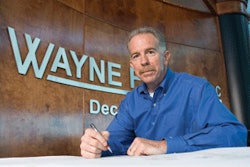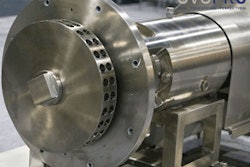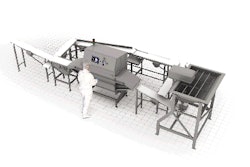Georgia Tech researchers have been studying cost-effective automation solutions to re-hang birds onto shackles after the chiller. Their efforts have led to two different systems approaches, each with the potential to enhance worker safety and reduce production costs.
The need for automation
In a majority of poultry plants in the United States – and in other countries too – an immersion water chiller is used to chill birds. After exiting the chiller, the birds currently are manually transferred to a shackle line for further processing. This is an extremely tedious task that typically requires four to six people to meet production requirements. The task is further complicated by the unstructured nature of the process. Birds are dropped from the chiller in random positions onto a re-hang table. Here, they are manually re-hung onto a shackle line, often while also being visually graded for quality.
There are growing issues with this process. Firstly, the continual reliance on humans to perform this type of task taxes an already limited labour pool. Second, the constant potential for injury – due to the repetitive nature of the job – adds to concerns. Finally, there is the desire to integrate product sorting and grading under a more automated format that enhances process performance.
Alternative approaches
To address this challenge, Georgia Tech researchers have taken two different approaches to automating the process. The first approach employs an industrial robot, a vision system, and a tracking system together with a unique end-effector to handle the product. The second approach employs non-robotic elements that rely on more traditional flippers and chutes to feed the product onto a shackle pickup device.
Robotic system
The robotic approach incorporates a robotic arm, a vision system, and a tracking system. The pneumatic end-effector, which is made completely of USDA-approved materials and meets sanitation requirements, is capable of grasping and loading birds ranging in weight from 1.15 to 2.95kg. The vision system uses stereo colour imaging to locate a bird’s centroid position, identify its tail and legs for grasping, and determine whether its orientation is breast up or breast down. Image processing takes place at a rate of 450 milliseconds/bird. Lastly, the tracking system provides data on the location of the bird in relation to the conveyor belt and the shackle line.
Recent laboratory tests showed that the system accurately re-hung the birds 76% of the time, regardless of their orientation.
In those tests, the vision system, the end-effector and the robot trajectory contributed to the errors. Since that preliminary testing, significant improvements to all systems have been made.
In fact, the recent donation of a KUKA SS (stainless steel) robot to the team will greatly assist in system enhancements.
“The KUKA robot provides a proven industrial robot that is specifically designed for the food industry. This robot will allow the team to optimise the tracking of the bird on the conveyor as well as the shackle. This will dramatically improve the throughput of the system,” explained Gary McMurray, research engineer and project co-director.
Non-robotic system
The non-robotic approach incorporates a funnel conveyor, pneumatic orientation stations, a vision system and a shackling device. As the birds move through the system, they are oriented in steps until all exit in the same position.
“The beauty of the concept is its relative simplicity,” noted Dr McMurray. “It uses elements the industry is readily familiar with, and offers cost advantages over more sophisticated approaches.”
Value to industry
Researchers believe that, regardless of which design succeeds, the ultimate value of this project will be to help reduce labour demands in this area of the plant. Both systems will also have the ability to incorporate quality control checks as well as improve shackle utilisation and flexibility in second processing.
“In addition to performing the shackling task, the robotic system could easily be adapted to performing other tasks in a plant. For instance, the cone loading task is very similar,” added Dr McMurray.
Georgia Tech Research Institute
This article is based on one published in PoultryTech, which is published by the Agricultural Technology Research Program (ATRP), Food Processing Technology Division of the Georgia Tech Research Institute (GTRI). ATRP is conducted in co-operation with the Georgia Poultry Federation with funding from the Georgia Legislature, USA.




.jpg?auto=format%2Ccompress&fit=crop&h=167&q=70&w=250)











